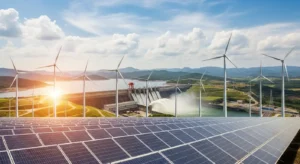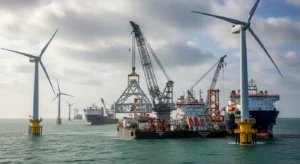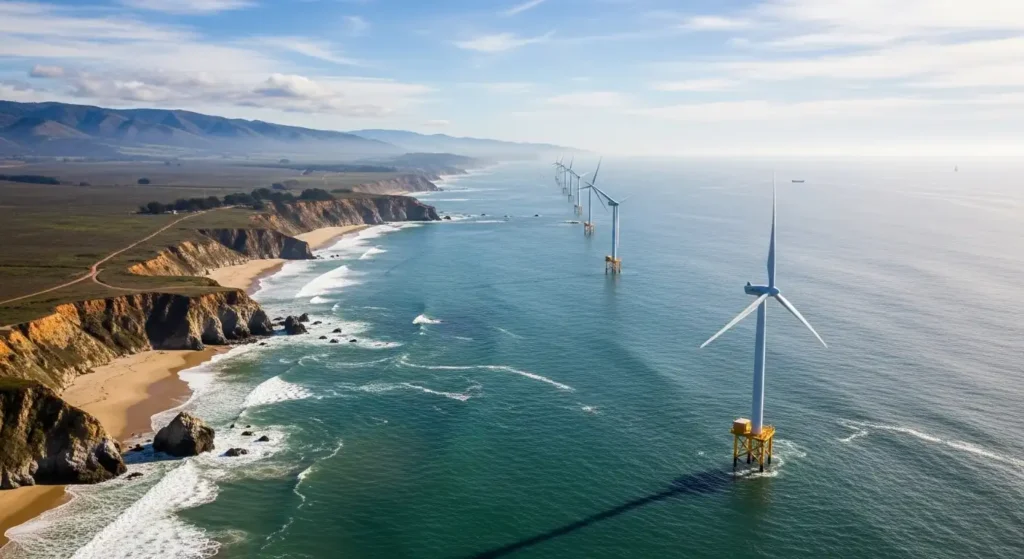The Golden State is opening a new chapter in its clean-energy journey. With strong coastal winds, deep-water offshore sites and an urgent need to expand renewable power, California is turning its attention to offshore wind. This emerging industry may bring fresh opportunities for jobs, sustainability and regional development—yet it also raises challenges around infrastructure, regulation and community impact.
Why Offshore Wind Matters for California
 California has set ambitious targets for achieving 100 % clean electricity by 2045, and offshore wind is part of the equation. The California Energy Commission (CEC) adopted a strategic plan in July 2024 to guide the deployment of offshore wind power off California’s coast. The state’s deep-water Pacific conditions mean that floating wind turbine technology will be required—making California something of a pioneer in this domain.
California has set ambitious targets for achieving 100 % clean electricity by 2045, and offshore wind is part of the equation. The California Energy Commission (CEC) adopted a strategic plan in July 2024 to guide the deployment of offshore wind power off California’s coast. The state’s deep-water Pacific conditions mean that floating wind turbine technology will be required—making California something of a pioneer in this domain.
By tapping offshore wind resources, California can diversify away from solar and on-shore wind, add new capacity during periods when the sun is not shining, and strengthen its clean-energy economy. Moreover, the state is already committing significant investment: the Legislature allocated US$225.7 million in 2025 to upgrade ports and infrastructure to support offshore wind.
Key Opportunities
The development of offshore wind in California presents a number of potential benefits:
- New clean-energy capacity: Offshore wind lease areas in the Morro Bay and Humboldt regions together may provide gigawatts of generation.
- Job creation and regional economic growth: According to state fact sheets, peak development could create over 8,000 jobs, many of them unionised, benefiting coastal ports and communities.
- Infrastructure revitalisation: Upgrading port facilities, manufacturing facilities and transmission will help support not only offshore wind but broader regional development in coastal California.
- Community benefit agreements and local training: Offshore wind leaseholders in California are required to engage with communities, including tribal governments, and establish training or hiring programs.
Major Challenges Ahead
Despite the promise, the offshore wind industry in California faces serious hurdles:
- Technical and cost barriers: Because of the deep Pacific waters off the California coast, floating turbine foundations are required—raising cost and complexity compared to fixed-bottom offshore wind in other regions.
- Environmental and cultural considerations: Deployment must account for marine ecosystems, fisheries, endangered species, and tribal cultural resources. The California Ocean Protection Council emphasises that meaningful steps are required to minimise potential harm.
- Transmission and grid integration: New offshore generation needs reliable connection to the grid; the California Independent System Operator (CAISO) is already recommending multi-billion-dollar transmission upgrades to channel offshore wind energy to inland load centres.
- Community engagement and equity: While jobs and investment may flow, ensuring benefits reach underserved communities and coastal regions requires deliberate planning and good governance. Training, inclusion and local hiring must be part of the rollout.
Community Impact: What It Means For Coastal Regions
 Coastal ports, shipyards and workforce hubs may experience a resurgence as offshore wind development advances. For example, equipment staging, vessel operations and maintenance will demand skilled labour and support services. The investment into port upgrades is a sign that California aims to capture manufacturing and logistics advantages.
Coastal ports, shipyards and workforce hubs may experience a resurgence as offshore wind development advances. For example, equipment staging, vessel operations and maintenance will demand skilled labour and support services. The investment into port upgrades is a sign that California aims to capture manufacturing and logistics advantages.
For coastal communities and tribes, there are both opportunities and responsibilities. Engagement must begin early to ensure developments are aligned with local interests, including fisheries, cultural resources and environmental justice. Programs that link offshore wind development to workforce training, community benefits and local hiring offer a pathway for inclusive growth.
What To Watch: Next Steps In The Offshore Wind Timeline
Several key milestones will affect how the offshore wind industry evolves in California:
- Advancement of the floating wind demonstration projects off Humboldt and Morro Bay.
- Progress in permitting, leasing and environmental review by federal and state agencies.
- Expansion of port and transmission infrastructure funded through state and federal investments.
- Community workforce initiatives and local supply-chain development to ensure local benefit.
How This Aligns With California’s Sustainability Goals
Offshore wind is a strategic fit for California’s broader sustainability agenda. It supports the state’s clean-electricity goals, reduces reliance on fossil fuels and creates a pathway for innovation in renewable technology. When developed responsibly, offshore wind also offers environmental benefits—by partnering with regenerative ocean-based industries and aligning with marine ecosystem protections.
From an economic and social justice perspective, the industry has the potential to deliver meaningful outcomes: good jobs, regional revitalisation, and infrastructure investment in historically under-served coastal counties. Ensuring that these outcomes materialise will require deliberate policy design, strong stakeholder engagement and accountability.
Conclusion
California’s offshore wind industry stands at a pivotal moment. With state strategy in place, significant investment aligned, and demonstration projects underway, the future is unfolding. Success will depend on balancing ambition with community care, innovation with equity, and growth with environmental protection. If managed well, this industry may become a shining example of how clean energy, economic renewal and social inclusion intersect.
For California, this is not just about generating power offshore—it’s about building resilient coastal communities, forging a new green economy and proving that sustainability and opportunity go hand-in-hand.

